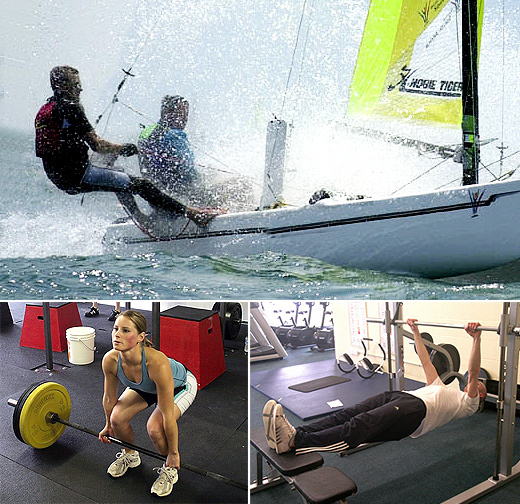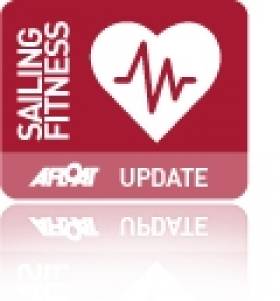Displaying items by tag: getting fit for sailing
Sailing Fitness: The Basics
Sailing and it's different disciplines and responsibilities vary greatly, and as such this article will be quite broad spectrum. It is however a major benefit to any athlete to make improvements in their strength, aerobic capacity, flexibility and mobility for health, performance and injury prevention.
Time
In order to make improvements in your performance you'll have to dedicate some time to your training. Family, work/studylife, travel etc all conspire against you, but the benefits are many. To see strength improvements try to work 3 hourly strength sessions per week. You can do mobility and flexibility work from home watching the television. Quality always trumps quantity. Plan your sessions ahead of time, know what you're going to do. Set yourself some benchmarks and try to improve and test yourself on them so you can guauge progress.
Injury Prevention
This is a key area for any athlete. Sailing encompasses many different individual tasks, such as hiking, trapezing or winching. Each different task will put a stress on a different joint and muscles, improving the range of motion and increasing stability in certain joints will reduce your risk of injury. Different joints have differing needs in terms of the above, so again a well designed programme should incorporate this. The most common areas people tend to have issues with are shoulders, hips and lower back, generally through sitting for long periods of time, either at a desk/car/tv/or even in the boat.
Warm up
This could equally have been put under the injury prevention heading. Always warm up before training or an event, there has been much research to suggest that a dynamic warm up gives far better performance benefits and injury prevention than the traditional 'static stretch' warmup. So what is a dynamic warmup, well basically it's the movement of your joint through it's full range of motion in a controlled fashion e.g leg swings, arm rotations, lunges, directional lunges etc. The clue is in the name for this one so try to work up a mild sweat, the aim is to increase blood and oxygen uptake in the muscles to prepare them for the work ahead aswell as mentally visualising what's coming down the line. Warm up for a little longer on a cold day and vice versa.
Strength Training
Of benefit to pretty much any sport and indeed daily life. Strength has a broad crossover and will make your tasks easier to perform both on the water and dry land.
Essentially strength training is adding external weight to your movements. Care should be taken and professional instruction sought on the basics of this to make sure the movement patterns you are doing are correct if, especially if you have no prior experience with weight training.
When putting together a training programme make sure it is designed to your needs. Make sure it's balanced, both in terms of time spent in the gym and catering for specificity of your tasks on the water. As above set some benchmarks and test yourself against them every few weeks. Examples of some good strength exercises to work into a programme include: Squats, lunges, deadlifts, pullups, overhead press, and bench press. These are compound movements that utilise more than one joint at a time. Leave isolation exercises for bodybuilders, the body naturally moves joints synergistically, make sure to train it that way.
Core Training
You'll have heard this term before and people tend to use it interchangeably. You won't go far wrong if you think of your core as your trunk, encompassing not just the abdominals, but all the stabilising musculature around your trunk and even including the hips. Being on the water, this is a pretty unstable environment so learning to transfer your force through a strong core is key. Example exercises for these include: planks, uni-lateral leg work, suspension training, deadlifts, hanging leg raises to name but a few.

Hiking/Trapezing is a blend of strength, endurance and mobility and stability, make sure you hit these withing your training to see an increase in performance on the water. Movements like the deadlift (left) and horizontal pulling (right) and pushing should be mainstays of your strength work.
Aerobic Training
Improving cardiovascular fitness there are a number of different approaches. The first is LSD training (Long Slow Distance) the object of which is to work the heart and lungs over a sustained period of time at a low intensity. This is essentially endurance training and can be done for 30mins+ Heart rate monitors are a good tool to monitor this and are widely available at extremely low prices in a wide range of shops.
Medium Intensity training is working at a slightly higher intensity than the above, this will increase the body's ability to cope under higher levels of stress and can be done for a period of 15-20mins.
High Intensity training pushing the heart rate to 90% of its maximum. This is pushing your body to its limits, it should be used as part of interval training, so think short bursts of high intensity coupled with rest periods at low intensity. This HIT is probably the least likely to be used in terms of sailing but nevertheless is a good tool to mix things up every so often. It should only be attempted once a good base line of fitness has been established.
Nutrition
Well there are thousands of websites dedicated solely to this subject so we'll just keep to the basics with reference to sailing. Sailing events range from 40minutes to month long endurance events. If you are embarking on the latter we'd advise some specific advise from a qualified professional.
If however you fall into the category of the first group, the important thing is to get some energy to fuel you throughout the event. We get energy primarily in the form of carbohydrates, so include some low to medium GI carbohydrate (Low GI foods release their energy over a longer period of time) foods a couple of hours before your event. e.g porridge/brown rice/wholegrain pasta, especially if you are out on the water for longer than an hour. You'll also want to couple this with some form of protein (lean meat/fish or food combining if you're a vegetarian).
Keep hydrated, drink water before the event, during if possible and after, especially in the heat, something you won't notice as much on the water.
So there we are, if there are any questions on the above feel free to post in the forum here, or drop us a line if you'd like to see any specific articles in relation to training etc.
























































